Connecticut is characterized by its diverse geography, featuring a mix of coastal areas, rolling hills, and forested regions. Discover the beauty and diversity of Connecticut’s avian life with our guide to Blue Birds in Connecticut.
This free photo guide will not only help you identify the different species of blue birds found in the state but also provide valuable information on their habits and habitats. Whether you are a seasoned birder or a beginner, this guide is a must-have for anyone interested in bird watching in Connecticut. Grab your binoculars, download your free photo guide, and let’s embark on a bird-watching adventure together!
Blue Birds Found In Connecticut
Connecticut’s varied geography makes it a hotspot for a diverse range of bird species. The coastline, rivers, and wetlands provide ideal habitats for waterfowl, while the forests and woodlands are home to many songbirds and raptors. The state’s position along the Atlantic Flyway, a major bird migration route, also means that a variety of bird species pass through Connecticut during their migratory journeys, adding to the state’s avian diversity.
Indigo Bunting


| Feature | Measurement |
|---|---|
| Scientific Name | Passerina cyanea |
| Length | 4.5–5.1 in |
| Wingspan | 7.1–9.1 in |
| Weight | 11.2–21.4 g |
The Indigo Bunting is a strikingly vibrant songbird, often hailed for its brilliant blue plumage and melodic song that graces woodlands and meadows during the warmer months.
Appearance: Males are renowned for their bright indigo blue feathers, which can appear darker in certain lights. Females and juveniles, on the other hand, are brown with subtle hints of blue on their wings and tail. The species lacks the vibrant streaking or spotting commonly found in many other songbirds.
Diet: Indigo Buntings primarily subsist on seeds, especially during non-breeding seasons. During the breeding season, they also consume a variety of insects such as beetles, caterpillars, and spiders, providing essential protein for their growing chicks.
Reproduction: Indigo Buntings build their nests close to the ground in shrubs or low tree branches. These nests, crafted meticulously with grasses and other plant materials, cradle clutches of typically 3 to 4 eggs. After hatching, the young are fed by both parents until they’re ready to fledge.
Eastern Bluebird
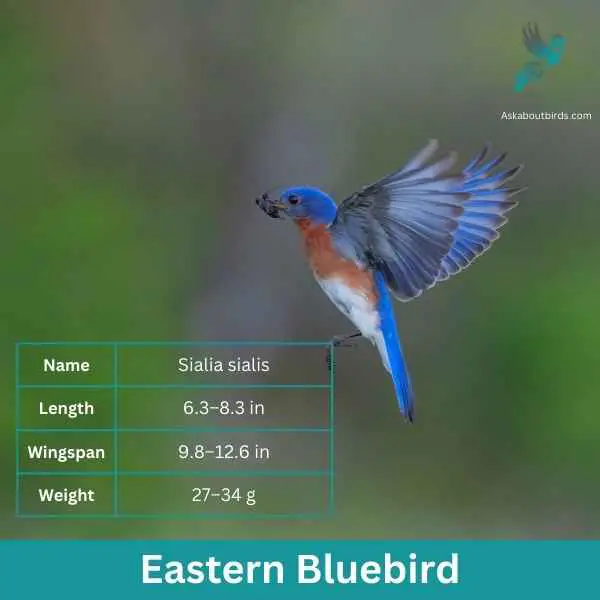
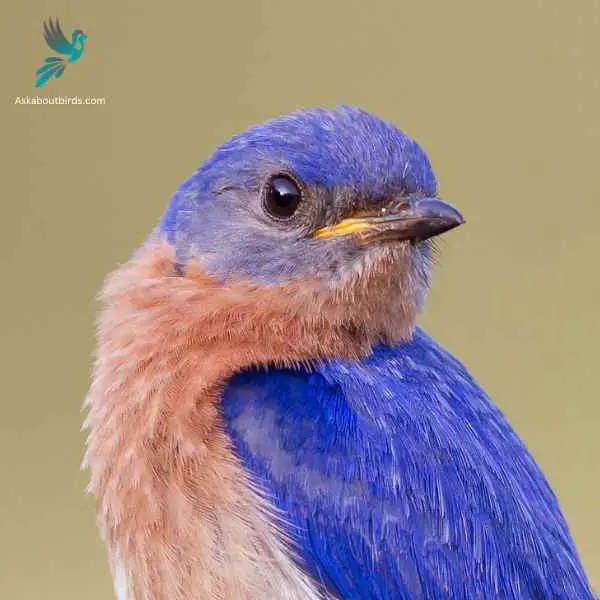
| Feature | Measurement |
|---|---|
| Scientific Name | Sialia sialis |
| Length | 6.3–8.3 in |
| Wingspan | 9.8–12.6 in |
| Weight | 27–34 g |
The Eastern Bluebird (Sialia sialis) is a small thrush found in open woodlands, farmlands, and orchards, and is recognized for its vibrant blue and red coloration. Male Eastern Bluebirds are dazzling with bright blue upperparts and a rusty or brick-red throat and breast, while females, though less colorful, still offer a similar pattern. The bird is native to North America and is commonly seen east of the Rockies, from Canada to the Gulf States and southeastern Arizona to Nicaragua.
Eastern Bluebirds feed on insects, wild fruit and berries. They have a gentle nature and are often seen perched alone or in small groups in the open, scanning the ground for prey. They are cavity nesters and will use old woodpecker holes or birdhouses if they are the right size.
Black-throated Blue Warbler
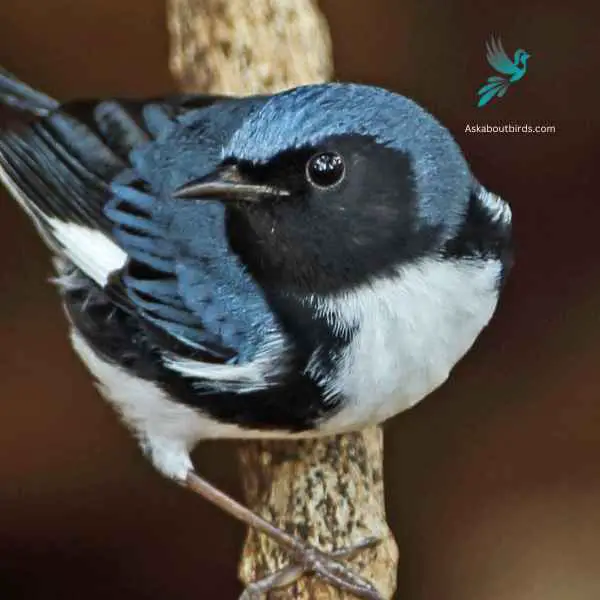
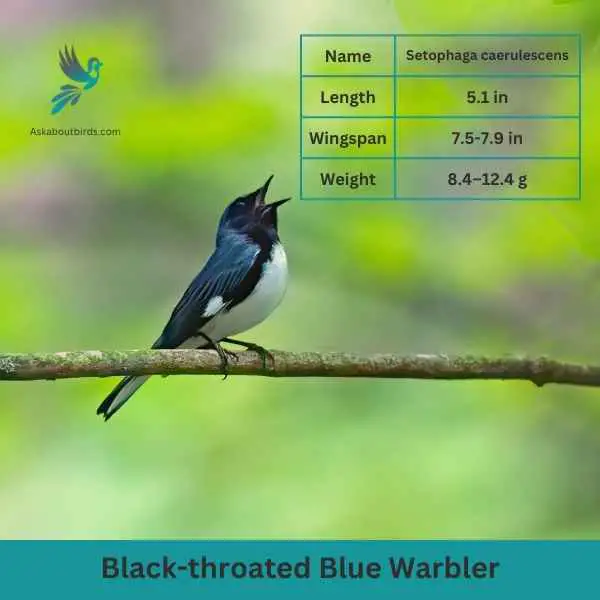
| Feature | Measurement |
|---|---|
| Scientific Name | Setophaga caerulescens |
| Length | 5.1 in |
| Wingspan | 7.5-7.9 in |
| Weight | 8.4–12.4 g |
The Black-throated Blue Warbler is a small migratory bird that breeds in the eastern United States and parts of Canada. The male Black-throated Blue Warbler displays a striking appearance with deep blue plumage on its upperparts, contrasting sharply with a black throat and a white belly. Females, on the other hand, have more muted colors, featuring grayish-olive plumage with a lighter throat.
These warblers prefer deciduous and mixed woodlands, where they forage actively for insects and spiders. They have a slender bill, which they use to extract prey from foliage and tree bark. During the breeding season, males perform courtship displays, showcasing their vibrant plumage and singing a high-pitched song to attract mates.
Black-throated Blue Warblers are known for their long-distance migration. They spend their winters in the Caribbean and Central America, where they inhabit various forested habitats. They construct cup-shaped nests in trees or shrubs, often placing them close to the ground.
Blue Grosbeak
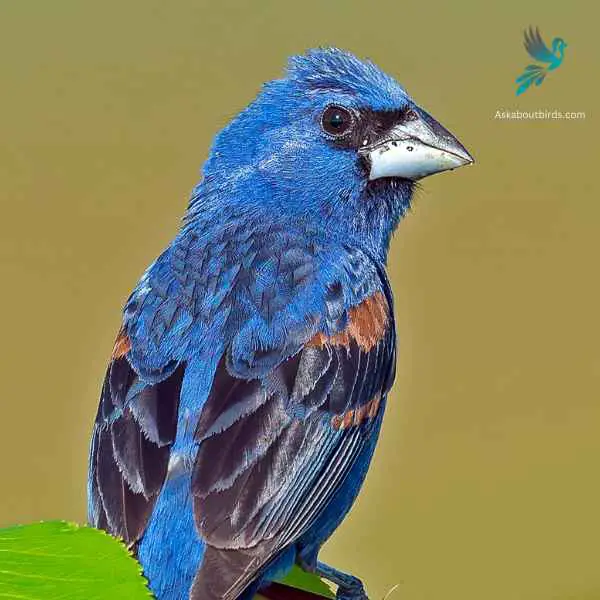
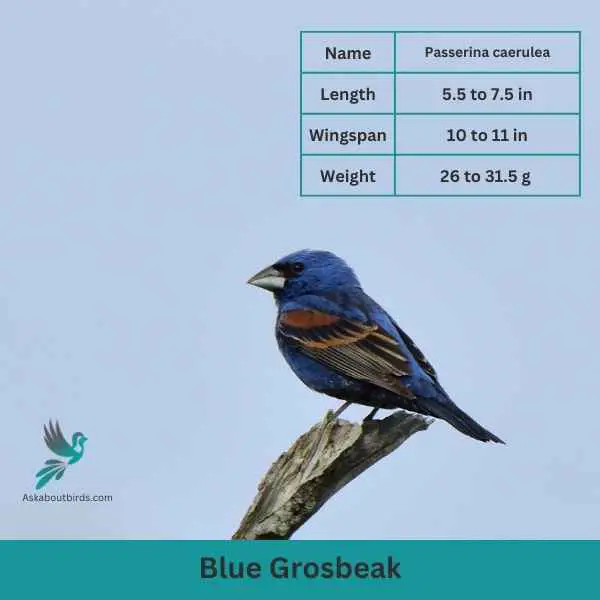
| Feature | Measurement |
|---|---|
| Scientific Name | Passerina caerulea |
| Length | 5.5 to 7.5 in |
| Wingspan | 10 to 11 in |
| Weight | 26 to 31.5 g |
The Blue Grosbeak is a medium-sized songbird found in North and Central America. The male Blue Grosbeak displays stunning plumage with deep blue feathers on its body and head, while the female has more subdued brownish tones. Both sexes have a thick, conical bill, which gives them their name “grosbeak,” meaning large beak.
These birds prefer open habitats such as grasslands, brushy areas, and woodland edges. Blue Grosbeaks are known for their melodious songs, which consist of a series of rich and varied notes. They primarily feed on seeds and insects, using their strong beaks to crack open seeds and forage on the ground or in low vegetation.
Blue Jay
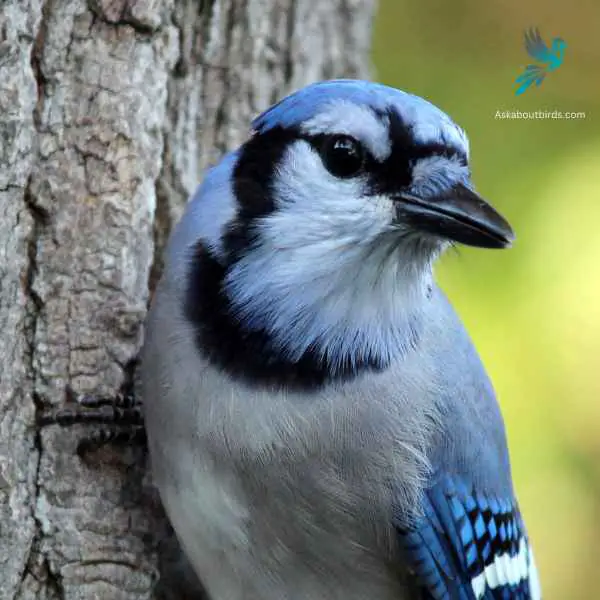
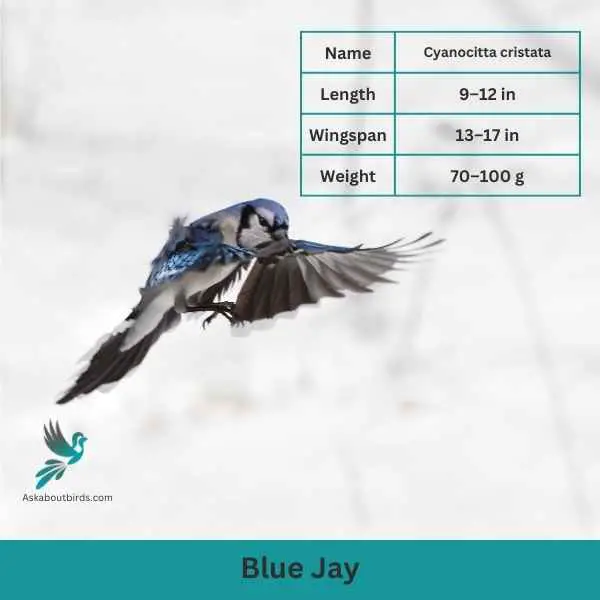
| Feature | Measurement |
|---|---|
| Scientific Name | Cyanocitta cristata |
| Length | 9–12 in |
| Wingspan | 13–17 in |
| Weight | 70–100 g |
The Blue Jay is a vibrant and easily recognized bird, known for its intelligence, distinctive calls, and bold behavior, commonly found throughout the eastern and central United States.
Appearance: The Blue Jay sports a striking blue upper body with white and black markings. Its face has a pronounced white patch with a black necklace that runs across the throat and around the head. The bird also features a pronounced blue crest, which can be raised or lowered, and its wings and tail are brightly colored with black bars and white tips.
Diet: Blue Jays are omnivores. Their diet consists primarily of seeds, nuts, especially acorns, fruits, and small insects. They’ve also been known to eat eggs or nestlings of other birds occasionally. Blue Jays often store food items in caches to eat later.
Reproduction: Blue Jays are monogamous birds that form long-lasting pair bonds. They typically build their nests in trees or large shrubs, constructing them from twigs, grass, and sometimes using mud as a binder. The female lays a clutch of 3 to 6 eggs, which are pale blue or sometimes white with brown speckles.
Little Blue Heron
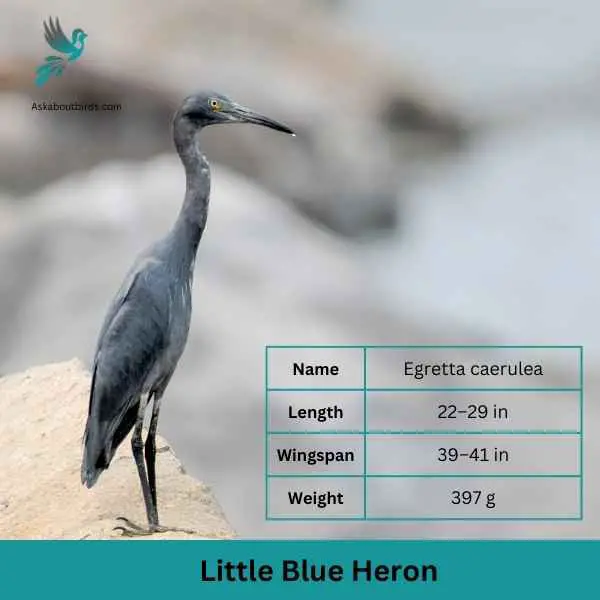
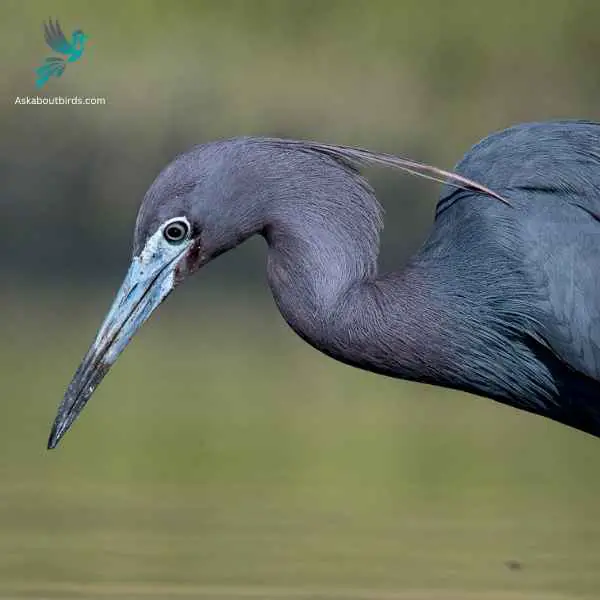
| Feature | Measurement |
|---|---|
| Scientific Name | Egretta caerulea |
| Length | 22–29 in |
| Wingspan | 39–41 in |
| Weight | 397 g |
The Little Blue Heron is a slender and elegant wading bird, often seen foraging in freshwater or saltwater habitats, especially in the southeastern parts of the United States.
Appearance: This heron undergoes a fascinating color transition as it matures. Juvenile Little Blue Herons are white, but they gradually acquire the slate-blue plumage that characterizes adults. The adult has a dark blue-gray body with a purplish neck and head. Their bill is grayish with a black tip.
Diet: The diet of the Little Blue Heron consists mainly of small fish, but they also feed on crustaceans, insects, and other small aquatic animals. Using stealth, they slowly stalk their prey in shallow waters before striking with their long, sharp bill.
Reproduction: Little Blue Herons nest in colonies, often with other wading birds. They build platform nests in trees or shrubs close to water bodies. The female typically lays a clutch of 3 to 5 pale blue eggs. Both parents participate in incubation and feeding the chicks once they hatch.
Cliff Swallow
| Scientific Name | Length | Wingspan | Weight |
|---|---|---|---|
| Petrochelidon pyrrhonota | 5-6 in | 11-12 in | 0.8-1.0 oz |
The Cliff Swallow is a small, sociable bird known for its distinctive appearance and nesting behavior.
Appearance: The Cliff Swallow has a shiny blue-black back and crown, a chestnut face, and a white forehead. The underparts are buff to cinnamon, and the tail is squared or slightly notched. Males and females have similar plumage.
Diet: Cliff Swallows feed primarily on flying insects, which they catch in the air. Their diet includes a variety of insects such as flies, wasps, ants, and beetles.
Reproduction: Cliff Swallows are colonial nesters and build their mud nests on vertical cliffs or structures like bridges and buildings. The female lays 3 to 6 eggs, which are incubated for about 14 to 16 days. Both parents feed the young and defend the nest.
Belted Kingfisher

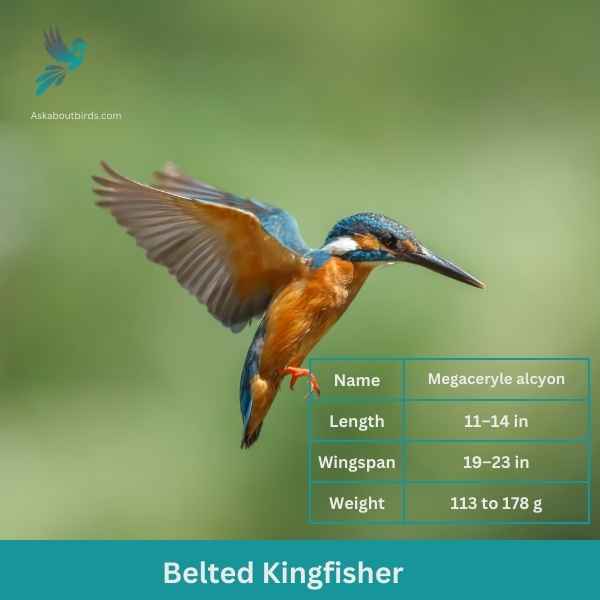
| Feature | Measurement |
|---|---|
| Scientific Name | Megaceryle alcyon |
| Length | 11–14 in |
| Wingspan | 19–23 in |
| Weight | 113 to 178 g |
The Belted Kingfisher is a distinctive and easily recognizable bird, frequently observed near water bodies, where it can be seen diving headfirst to catch prey.
Appearance: Sporting a prominent crest, the Belted Kingfisher has a slate blue-gray upper body and white underparts. Males possess a single blue band across their white chests, while females have an additional rufous band, making them one of the few bird species where females are more brightly colored than males. Their bill is long, sharp, and dagger-like.
Diet: As expert fishers, Belted Kingfishers mainly prey on small fish, but they’ll also consume crustaceans, insects, and amphibians. They’re known for their hunting tactic of hovering over water, spotting their prey, and then diving swiftly to snatch it.
Reproduction: Belted Kingfishers nest in burrows which they excavate in sandy or earthen banks, usually adjacent to water. The tunnel can be anywhere from 3 to 6 feet long, ending in a chamber. Within this chamber, the female lays a clutch of 5 to 8 white eggs.
Tree Swallow
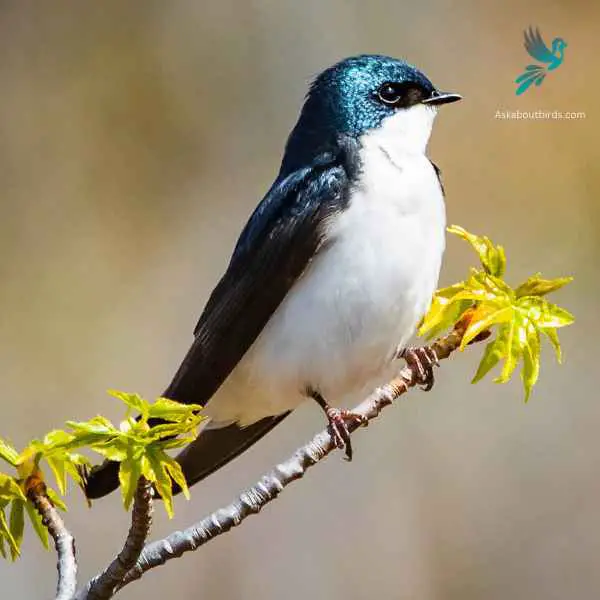
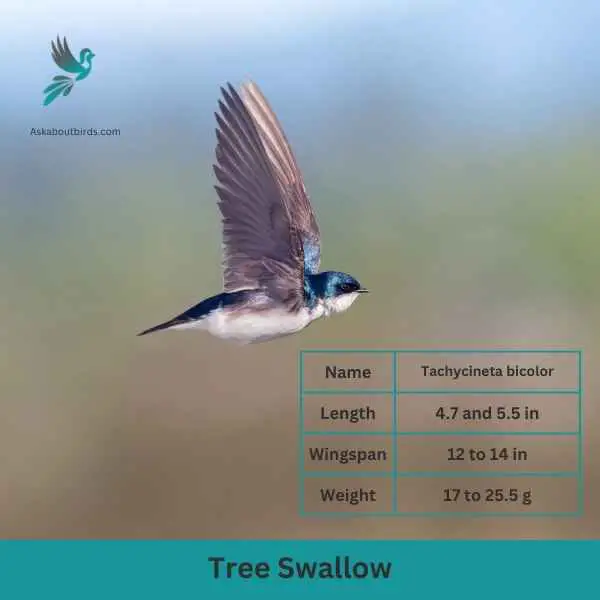
| Feature | Measurement |
|---|---|
| Scientific Name | Tachycineta bicolor |
| Length | 4.7 and 5.5 in |
| Wingspan | 12 to 14 in |
| Weight | 17 to 25.5 g |
The Tree Swallow is a graceful and agile bird, best recognized for its iridescent blue-green upperparts and sweeping flight patterns over open fields and water.
Appearance: The Tree Swallow is sleek with a streamlined body. The upperparts shine with a blue-green iridescence while the underparts are white. They possess long, pointed wings and a slightly forked tail, aiding in their agile flight.
Diet: Tree Swallows primarily feed on flying insects, skillfully catching them mid-air. During colder months when insects are scarce, they can switch to a diet of berries, particularly those of the bayberry, which other birds might find hard to digest.
Reproduction: Tree Swallows are cavity-nesters, typically choosing natural holes in trees or using bird boxes. They line their nests with feathers, creating a soft environment for the eggs. The female will lay a clutch of 4 to 7 white eggs.
Barn Swallow
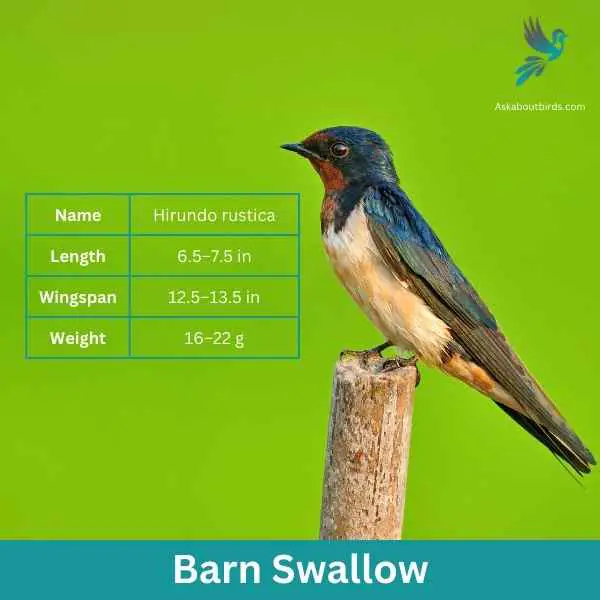

| Feature | Measurement |
|---|---|
| Scientific Name | Hirundo rustica |
| Length | 6.5–7.5 in |
| Wingspan | 12.5–13.5 in |
| Weight | 16–22 g |
The Barn Swallow is a sleek, agile bird renowned for its graceful flight patterns and iconic forked tail, often seen darting over fields and water bodies in search of flying insects.
Appearance: Barn Swallows have deep blue, almost iridescent, upperparts and a rufous to tawny underbelly. Their distinctively forked tail and long wings give them a streamlined look. Both males and females have a similar appearance, though males often exhibit slightly brighter colors and a deeper fork in the tail.
Diet: Barn Swallows feed primarily on flying insects, which they catch in mid-air during their agile and acrobatic flights. Their diet includes flies, beetles, moths, and other small flying insects.
Reproduction: Barn Swallows are known for building their mud nests on man-made structures, particularly barns, bridges, and eaves. The nest is cup-shaped and made from mud pellets, often lined with feathers. The female lays a clutch of 4 to 6 eggs.
Purple Martin
| Scientific Name | Length | Wingspan | Weight |
|---|---|---|---|
| Progne subis | 7.5-8.7 in | 15.3-16.1 in | 1.6-2.1 oz |
The Purple Martin is the largest North American swallow known for its acrobatic flight and sociable behavior.
Appearance: Adult male Purple Martins have iridescent, dark blue-purple plumage overall, while females and young have a duller, grayish-brown upperparts and white underparts with a grayish chest. The wings and tail are blackish.
Diet: Purple Martins feed almost exclusively on flying insects, including dragonflies, damselflies, flies, beetles, wasps, and moths. They catch their prey in the air, often flying high and covering large distances in search of food.
Reproduction: Purple Martins are cavity-nesting birds and have come to rely on human-provided nesting structures in the eastern parts of their range. The female lays a clutch of 3 to 6 eggs, and incubates them for about 15 to 18 days. Both parents feed the young and defend the nest.
Cerulean Warbler
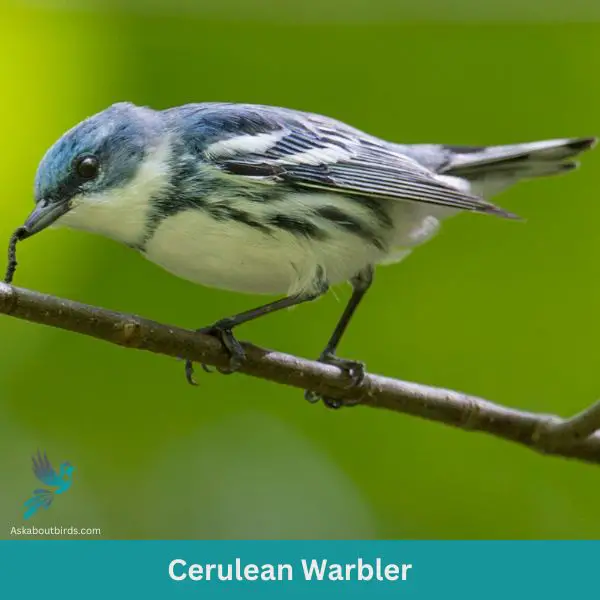
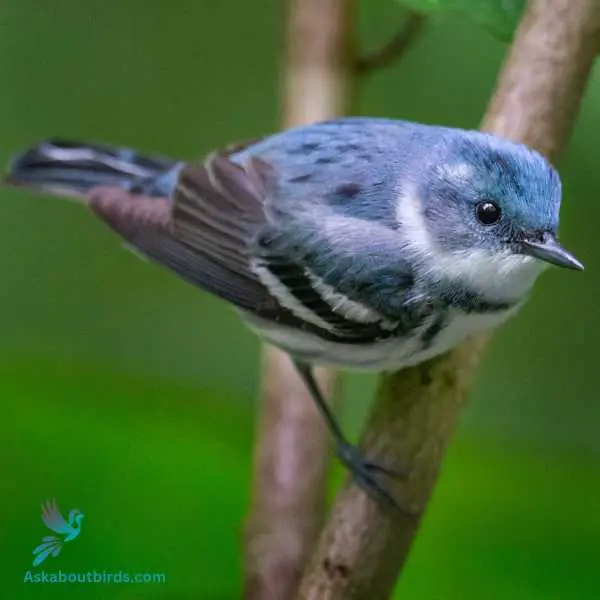
| Trait | Cerulean Warbler |
|---|---|
| Scientific Name | Setophaga cerulea |
| Length | 4.5 inches |
| Wingspan | 7.9-8.7 inches |
| Weight | 0.3-0.4 ounces |
The Cerulean Warbler is a striking songbird known for its sky-blue plumage and flitting movements in the forest canopy.
Appearance: Males boast a vibrant cerulean blue color on their upperparts, with streaked underparts, and a black necklace. Females have a more subdued bluish-green hue and lack the prominent black markings seen in males.
Diet: The diet of the Cerulean Warbler is predominantly made up of insects and spiders. They actively forage high in the treetops, gracefully maneuvering through leaves and branches.
Reproduction: Cerulean Warblers nest in the upper branches of tall deciduous trees. The female weaves a shallow cup-shaped nest and lays a clutch of 3-5 eggs.
Where to Spot Connecticut’s Blue Birds
Connecticut, with its mix of coastal, forest, and urban areas, is a haven for birdwatchers and especially those on the lookout for blue birds. Here are the top spots in the state for witnessing the greatest diversity of these feathered blue beauties in:
- Hammonasset Beach State Park: As Connecticut’s largest shoreline park, it offers over 2 miles of beach and a large variety of bird species, making it a popular spot for birdwatching, especially during the migratory seasons.
- White Memorial Conservation Center: Located in Litchfield, this 4,000-acre conservation area offers a diverse habitat for a wide range of bird species. Its extensive trail system through woods and wetlands makes it an ideal location for birdwatching.
- Sherwood Island State Park: As Connecticut’s first state park, it offers a wide variety of habitats, from wetlands to woodlands, and is an excellent location for spotting blue birds as well as other migratory species.
- Bent of the River Audubon Center: Located in Southbury, this 700-acre nature sanctuary offers a mix of forest, meadow, and river habitats, making it an excellent location for birdwatching throughout the year.
| State’s Blue Birds | Top Spots foe Blue Birds |
|---|---|
| New York’s Blue Birds | 1. Central Park, NYC 2. Montezuma National Wildlife Refuge 3 . Jamaica Bay Wildlife Refuge |
| Massachusetts’s Blue Birds | 1. Parker River National Wildlife Refuge 2. Plum Island 3. Quabbin Reservoir |
| Rhode Island’s Blue Birds | 1. Sachuest Point National Wildlife Refuge 2. Trustom Pond National Wildlife Refuge |
FAQs on Blue Bird Species Found in Connecticut
What should I consider when setting up a nest box for Eastern Bluebirds?
When setting up a nest box for Eastern Bluebirds, consider the following tips for the nest site: Choose a location that is open with scattered trees and avoid heavily wooded areas. The entrance hole should be about 1.5 inches in diameter to prevent larger birds from entering. Install a predator guard on the pole to prevent predators like snakes and raccoons from accessing the bluebird nest box trails below. Make sure the nest box has ventilation holes at the top and drainage holes at the bottom. Also, regularly monitor the nest box for signs of house sparrows, European starlings, or other pests, and remove their nests if found.
What type of food should I provide in a bird feeder to attract Eastern Bluebirds?
Eastern Bluebirds primarily feed on insects, but they also enjoy fruits and berries. In a bird feeder, you can provide mealworms, which are a favorite of bluebirds. Sunflower seeds are also appreciated but offer them in moderation as bluebirds primarily eat insects. During winter, suet cakes with embedded insects can be a good option to provide the necessary fats and energy, especially for male Eastern bluebird. Additionally, planting native trees and shrubs that produce berries can also help in providing natural winter food sources.
How to attract bluebirds to your backyard?
Attracting bluebirds can be a rewarding experience as they are beautiful birds and beneficial to the ecosystem. To attract bluebirds, set up nest boxes in your backyard as they prefer nesting in boxes or natural cavities. Make sure the entrance hole is the right size for small birds to deter larger birds and predators. Also, place the bluebird nest box plans or boxes in open areas with scattered trees and away from heavily wooded areas. Providing bird feeders with sunflower seeds can also help attract them. Regularly clean the nest boxes and remove old nest materials to maintain a neat nest environment
How to control house sparrows from occupying bluebird nest boxes?
House sparrows are an invasive species and can pose a threat to nesting bluebirds by taking over their nest boxes. To control house sparrows, make the entrance hole of the bluebird nest box smaller as house sparrows prefer larger entrance holes. Also, placing the nest or bluebird nesting box in an open area away from buildings can discourage house sparrows as they prefer nesting near buildings. Regular monitoring of the nest boxes and removing any house wrens or sparrow nests found can also help in controlling their population.
